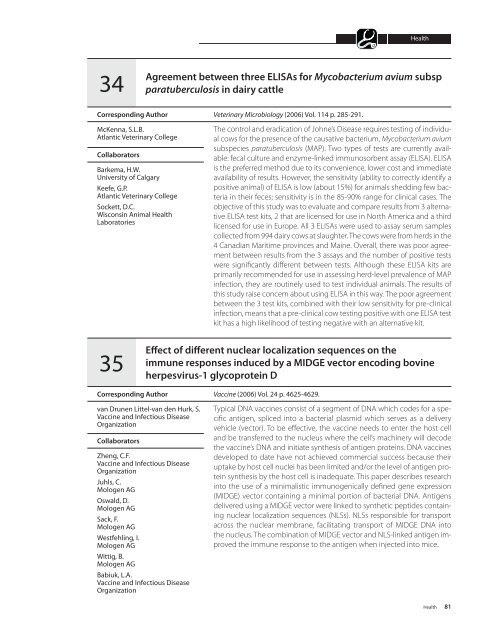A52-75-2007E.pdf - AgroMedia International Inc
A52-75-2007E.pdf - AgroMedia International Inc
A52-75-2007E.pdf - AgroMedia International Inc
Create successful ePaper yourself
Turn your PDF publications into a flip-book with our unique Google optimized e-Paper software.
Health34Agreement between three ELISAs for Mycobacterium avium subspparatuberculosis in dairy cattleCorresponding AuthorMcKenna, S.L.B.Atlantic Veterinary CollegeCollaboratorsBarkema, H.W.University of CalgaryKeefe, G.P.Atlantic Veterinary CollegeSockett, D.C.Wisconsin Animal HealthLaboratoriesVeterinary Microbiology (2006) Vol. 114 p. 285-291.The control and eradication of Johne’s Disease requires testing of individualcows for the presence of the causative bacterium, Mycobacterium aviumsubspecies paratuberculosis (MAP). Two types of tests are currently available:fecal culture and enzyme-linked immunosorbent assay (ELISA). ELISAis the preferred method due to its convenience, lower cost and immediateavailability of results. However, the sensitivity (ability to correctly identify apositive animal) of ELISA is low (about 15%) for animals shedding few bacteriain their feces; sensitivity is in the 85-90% range for clinical cases. Theobjective of this study was to evaluate and compare results from 3 alternativeELISA test kits, 2 that are licensed for use in North America and a thirdlicensed for use in Europe. All 3 ELISAs were used to assay serum samplescollected from 994 dairy cows at slaughter. The cows were from herds in the4 Canadian Maritime provinces and Maine. Overall, there was poor agreementbetween results from the 3 assays and the number of positive testswere significantly different between tests. Although these ELISA kits areprimarily recommended for use in assessing herd-level prevalence of MAPinfection, they are routinely used to test individual animals. The results ofthis study raise concern about using ELISA in this way. The poor agreementbetween the 3 test kits, combined with their low sensitivity for pre-clinicalinfection, means that a pre-clinical cow testing positive with one ELISA testkit has a high likelihood of testing negative with an alternative kit.35Effect of different nuclear localization sequences on theimmune responses induced by a MIDGE vector encoding bovineherpesvirus-1 glycoprotein DCorresponding Authorvan Drunen Littel-van den Hurk, S.Vaccine and Infectious DiseaseOrganizationCollaboratorsZheng, C.F.Vaccine and Infectious DiseaseOrganizationJuhls, C.Mologen AGOswald, D.Mologen AGSack, F.Mologen AGWestfehling, I.Mologen AGWittig, B.Mologen AGBabiuk, L.A.Vaccine and Infectious DiseaseOrganizationVaccine (2006) Vol. 24 p. 4625-4629.Typical DNA vaccines consist of a segment of DNA which codes for a specificantigen, spliced into a bacterial plasmid which serves as a deliveryvehicle (vector). To be effective, the vaccine needs to enter the host celland be transferred to the nucleus where the cell’s machinery will decodethe vaccine’s DNA and initiate synthesis of antigen proteins. DNA vaccinesdeveloped to date have not achieved commercial success because theiruptake by host cell nuclei has been limited and/or the level of antigen proteinsynthesis by the host cell is inadequate. This paper describes researchinto the use of a minimalistic immunogenically defined gene expression(MIDGE) vector containing a minimal portion of bacterial DNA. Antigensdelivered using a MIDGE vector were linked to synthetic peptides containingnuclear localization sequences (NLSs). NLSs responsible for transportacross the nuclear membrane, facilitating transport of MIDGE DNA intothe nucleus. The combination of MIDGE vector and NLS-linked antigen improvedthe immune response to the antigen when injected into mice.Health 81





